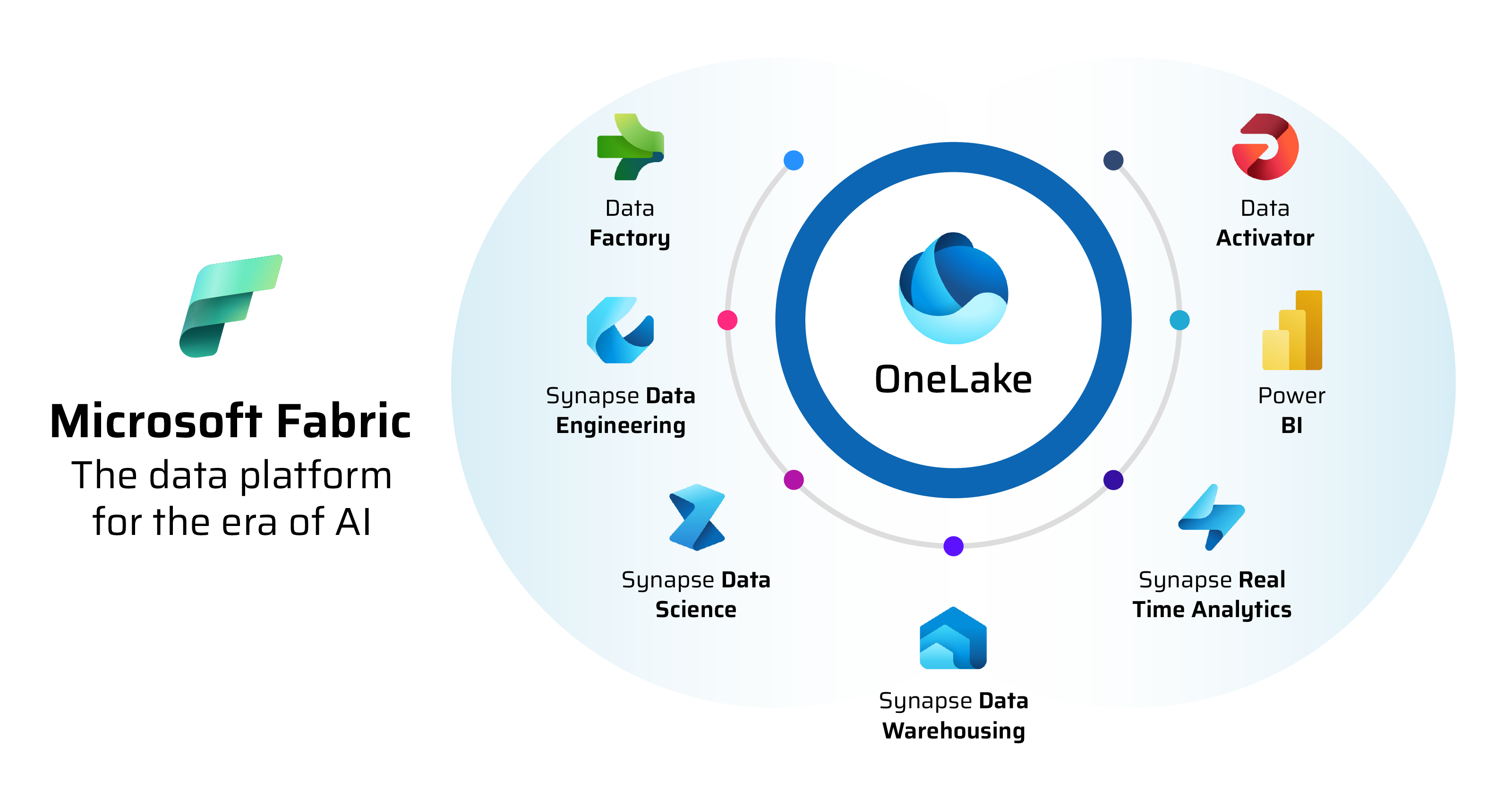
Listen to this blog
In today’s digital era, organizations grapple with the challenge of managing fragmented data scattered across on-premises systems, cloud platforms, and diverse applications. This fragmentation disrupts efficiency, delays actionable insights, and complicates decision-making. To remain competitive, businesses need a solution that unifies their data ecosystem, streamlines management, and provides seamless, real-time access to insights.
Data Fabric offers a transformative solution by integrating siloed data sources into a cohesive framework. It enables real-time access and analysis, vital for timely decision-making and Generative AI applications. Leveraging advanced technologies like active metadata, Machine Learning, and automation, Data Fabric simplifies data access, governance, and orchestration. It accelerates AI model development through data virtualization, ensuring consistent, high-quality data while automating governance to maintain compliance and integrity.
By unifying data, fostering collaboration, and supporting both operational and analytical needs, data fabric enhances efficiency, drives innovation in AI, and empowers organizations to swiftly adapt to market demands.
What is Microsoft Fabric?
In a complex digital landscape, where data is often siloed and scattered, a data fabric serves as a unified analytics platform, simplifying access, integration, and visualization to unlock the full potential of organizational data.
By connecting disparate data sources into a cohesive view, data fabric eliminates silos and reduces the need for complex migrations. Centralized storage and automated workflows ensure seamless data ingestion, transformation, and preparation for analysis, while techniques like data virtualization and federated querying enable real-time access across systems. This streamlined approach enhances operational efficiency and provides actionable insights, allowing businesses to make smarter, faster decisions.
Data fabric also simplifies analytics by consolidating multiple functionalities into a single platform, reducing the complexity of managing disparate tools. Its end-to-end integration covers the entire data lifecycle—from ingestion and processing to analysis and visualization—facilitating collaboration and improving efficiency across teams.
By unifying essential components like storage, engineering, integration, and visualization, data fabric empowers organizations to harness their data effectively, drive innovation, and achieve a competitive edge in an increasingly data-driven world.
Microsoft Fabric’s value proposition: How can it help your data ecosystem?
Microsoft Fabric integrates data storage, processing, and analysis, boosting collaboration, automation, and decision-making—enhancing efficiency and scalability. Let’s dive deeper below
- Microsoft Fabric unifies data integration, analytics, and AI-driven insights into a single platform, enabling faster decisions, greater efficiency, and seamless innovation.
- This enables a single data persona to manage ingestion, ELT/ETL, modeling, and data products in one platform, streamlining workflows and accelerating insights with AI-driven automation.
- It accelerates speed to market and reduces setup time by unifying data workflows with pre-built connectors, low-code tools, and AI-driven automation for faster insights and innovation.
Core Features of Microsoft Fabric
Microsoft Fabric combines AI, automation, and seamless collaboration to transform data management—enhancing efficiency, driving innovation, and enabling faster decision-making. Let’s explore more below.
- AI-driven capabilities: Microsoft Fabric integrates AI with data management tools to simplify and enhance data handling.
- Co-pilot integration: Boosts productivity with real-time suggestions, task automation, and intuitive workflows in Power BI and Data Factory.
- Advanced automation: Streamlines development with automated code generation, industry templates, and accelerated Machine Learning model and data pipeline creation.
- OneLake: A centralized data lake that unifies storage, ensures data consistency, and reduces redundancy.
- Centralized data hub: Enhances collaboration with shortcuts and easy access for teams to discover, share, and analyze data.
- Real-time collaboration: Notebook co-editing allows multiple users to work simultaneously, driving faster outcomes.
Microsoft Fabric Components
- Data ingestion and transformation (Data Factory): Azure Data Factory and dataflows streamline workflows with integration, transformation, automation, security, and scalability.
- Data engineering: Synapse Lakehouse integrates data engineering with storage, processing, transformation, governance, and integration.
- Data science and Machine Learning: Integrating ML models in Power BI combines data science with predictive, scalable analytics.
- Real-time intelligence: Event-driven processing in a data fabric powers real-time intelligence, scalability, AI, and automation.
- Visualization and reporting (Power BI)
Dynamic dashboards in a data fabric enable real-time visualization, interactive reporting, scalability, security, and decision-making.
Microsoft Fabric Landscape

Industry applications of Microsoft Fabric
Retail - Microsoft Fabric integrates data with OneLake to personalize customer experiences, improve demand forecasting, optimize supply chains, reduce costs, and drive growth through AI-driven insights and real-time analytics.
Healthcare - Transforming healthcare, Microsoft Fabric integrates diverse data with OneLake to enable personalized care, real-time monitoring, AI-driven insights, operational efficiency, and compliance, empowering providers to improve outcomes and address public health challenges.
BFSI - The BFSI sector leverages AI-driven fraud detection, customer segmentation, and compliance, while Microsoft Fabric enhances security, personalizes financial services, and streamlines reporting with real-time analytics, fostering trust, innovation, and efficiency.
Telecom- Microsoft Fabric empowers telecoms with AI-driven churn prediction, real-time network optimization, and OneLake integration, enabling proactive customer retention, anomaly detection, targeted strategies, and innovation for improved experiences and operational excellence.
Integration with third-party tool
Seamless data integration: Microsoft Fabric cohesively integrates with a variety of third-party tools, enabling businesses to create a cohesive and unified data ecosystem. Let’s broadly discuss some examples.
SAP integration: Seamlessly syncs ERP data with advanced analytics, providing a comprehensive view of operations and performance. This unified approach empowers smarter decisions and boosts operational efficiency.
Salesforce integration: Flawlessly syncs CRM data to deliver a 360 view of customer interactions, sales, and marketing. Enables personalized experiences, optimized sales strategies, and enhanced marketing effectiveness, driving stronger relationships and business growth.
Google analytics integration: Effortlessly pulls website and digital marketing data into the analytics platform, providing deep insights into user behavior and campaign performance. Enables tracking key metrics, optimizing marketing strategies, and enhancing user engagement, driving data-informed digital success.
Organizations can smoothly connect their preferred tools while leveraging Microsoft Fabric’s advanced capabilities. This creates a unified data landscape that optimizes workflows, enhances collaboration, and unlocks deeper insights—all without disrupting existing processes.
Cross-Platform data sharing
- Microsoft Fabric enables seamless cross-platform data sharing, fostering collaboration, eliminating silos, ensuring reliable information flow, and empowering efficient, informed business decisions.
- This fosters team collaboration, ensures real-time data access, breaks silos, promotes transparency, enhances alignment and decision-making, driving cohesive data-driven strategies.
- Businesses can seamlessly share data across cloud, on-premises, and third-party apps, maximizing infrastructure. Create a unified ecosystem, streamline workflows, and empower data-driven strategic and operational excellence.
- The ability to share data across platforms strengthens governance by ensuring appropriate access, maintaining privacy, enhancing transparency, reducing risks, building trust, managing data responsibly, and enabling informed decisions.
Cost efficiency and scalability
- Pay-As-You-Go model- Microsoft Fabric offers a flexible, cost-effective pay-as-you-go pricing, allowing businesses to scale usage based on needs and optimize resources without overspending.
- Cost-effective pricing- Organizations pay only for the data storage, processing power, and analytics services they use, enabling precise cost control and eliminating expenses on unused resources.
- Cost scalability- As business needs grow, the platform allows companies to scale resources without significant upfront costs, aligning spending directly with consumption.
- Usage-based billing- Real-time usage tracking and detailed billing insights provide transparency, enabling informed financial decisions and optimizing spending to match demand.
Elastic scalability
Microsoft Fabric’s cloud-native architecture seamlessly scales to meet growing business needs, ensuring consistent performance and reliability.
Elastic scaling- Effortlessly expand storage, compute power, or users without infrastructure constraints, fostering innovation and growth while maintaining efficiency.
High-performance processing - Utilizes Azure’s cloud capabilities to process massive datasets in real-time, manage high transactional volumes, and perform complex analytics for quick insights and operational efficiency.
Resource optimization - Automatically adjusts resources based on workload demands, preventing overprovisioning, reducing costs, and enhancing performance, enabling businesses to focus on innovation.
Future trends and roadmap of Microsoft Fabric
We will delve into Microsoft Fabric's future trends and roadmap, highlighting how quantum computing, advanced NLP, and AI-driven automation will transform decision-making, optimize operations, and drive industry-specific innovation.
Quantum computing integration- Microsoft Fabric integrates quantum computing with fault-tolerant topological qubits, transforming data analytics and Machine Learning. It accelerates solutions for complex challenges like supply chain optimization, empowering businesses to drive innovation and growth.
Advanced Natural Language Processing (NLP): Advanced NLP enhances sentiment analysis, customer feedback, and document processing, enabling healthcare, finance, and retail to analyze unstructured data, gain efficiency, derive insights, and maintain a competitive edge.
AI-driven automation and predictive analytics: Microsoft Fabric enhances AI-driven automation, enabling businesses with minimal expertise to process data, uncover insights with predictive analytics, and improve forecasting for faster, more confident decision-making.
Evolution of data- driven decision making - Driving digital transformation, businesses leverage Microsoft Fabric's Machine Learning, predictive analytics, and real-time data for faster decisions, supported by tailored, industry-specific solutions for healthcare, finance, and retail challenges.
Conclusion
Microsoft Fabric is reshaping the way organizations harness the power of data, providing a unified platform that seamlessly integrates data, fuels advanced analytics, and drives AI-powered insights. With capabilities like real-time processing, elastic scalability, and a cost-effective, pay-as-you-go model, it empowers businesses to unlock efficiency, accelerate innovation, and make smarter, data-driven decisions. Looking ahead, Microsoft Fabric's roadmap, which includes breakthroughs in quantum computing, cutting-edge NLP, and industry-specific solutions, ensures it remains at the forefront of digital transformation, helping businesses not only adapt but thrive in an ever-changing, data-driven world.




